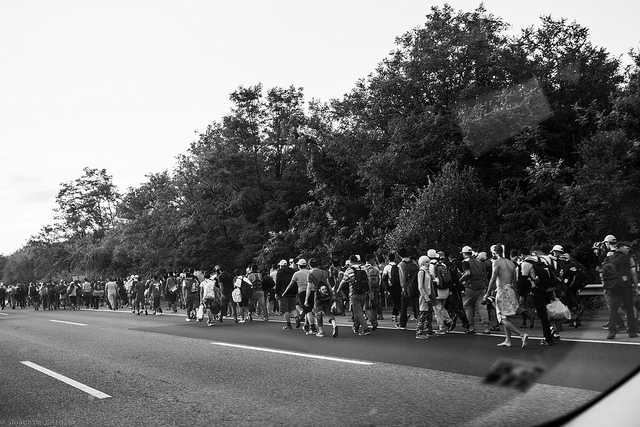The refugee crisis currently confronting Europe is the harbinger of things to come.
An unpredictable cocktail of prolonged drought and civil war in Syria has generated over six million internally displaced people, with another four million seeking refuge in Turkey, Lebanon, Iraq, Jordan and Egypt. Over one million Syrians are banging on the gates of Europe, not to mention tens of thousands of Iraqis, Iranians and Afghans. While some of them are ‘economic refugees’ seeking better lives for themselves and their families, the vast majority of the refugees are fleeing persecution and war.
As Robert Kagan has noted, those refugee flows, together with the terrorist attacks in Paris, threaten the cohesion of Europe, and with it the cohesion of the trans-Atlantic community: the West. The historically strong centrist parties are under pressure as right wing nationalism grows. Politically and economically, the European Union is in trouble.
Media commentary often suggests that upwards of 200 million people may need to be resettled as a result of climate change. This figure is generally attributed to Oxford Professor Norman Myers, though in recent years it has been discredited. As the Intergovernmental Panel on climate Change (IPCC 2014) has noted, there’s no reliable methodology for estimating the population movements that might result from global warming. Consequently, there’s no authoritative indication of the size or dynamics of potential ‘climate refugee’ flows.
Nonetheless, the World Bank and the IPCC have both drawn attention to the impacts on human security—health and relocation—that may result from global warming. The demand for resettlement could well be in the tens of millions.
In the absence of persecution, ‘economic refugees’ and ‘climate refugees’ aren’t covered by the 1951 UN Refugee Convention. The international lawyers tell us that there are no conventions, protocols, frameworks or agreements that enable individual states or the international community to provide protection to such people who cross international borders in search of help.
The UN Refugee Convention was a response to the human tragedy that was WWII. It was an entirely appropriate humanitarian response to events that, while not entirely unprecedented, were certainly unforeseen.
But with global warming, the international community finds itself in an entirely different situation. The migration of significant numbers of people, both within and across borders, is an inevitable consequence of a global temperature increase above 2 degrees centigrade—an increase that we already know will be exceeded. Resettlement pressures would almost certainly be amplified by other humanitarian issues, such as local conflicts, famine, floods and freak weather events that could affect hundreds of thousands of people at a time.
Instead of wrapping itself around the axle of legalities—a time-honoured way of shelving problems—the international community needs to address the climate migration question preemptively. It’s less a question of tweaking old conventions than it is one of creating new solutions to new problems. Unusually, time is on the side of action. Australia has an important part to play at both the strategic and diplomatic levels.
At the strategic level, we have a lot at stake. Notwithstanding its relative aridity, Australia looks like a vast and significantly under populated continent, particularly when viewed from the Indian sub-continent and densely populated nations like Indonesia. If, as predicted, temperature increases in north Africa, the Middle East and the Arabian Peninsula affect human habitability, it would be unsurprising were the international community to regard Australia as a major contributor to resettlement. And even if migration flows were restricted to the tens of millions, Australia could face almost irresistible pressure.
At the diplomatic level, there’s much that Australia could do.
First, it could lend its diplomatic weight to those nations urging reform of the UN. This isn’t to suggest that the UN be abolished or superseded, but rather that it be adapted to deal with contemporary and prospective issues. The UN and its agencies are the key institutions supporting the effectiveness of a rules-based international system. Global warming is a problem already crying out for a global rules-based solution.
Second, it could encourage both the strengthening and the refinancing of the UNHCR. To take just one example: it would be easier and kinder to begin now the managed resettlement of the Pacific communities that are already subject to rising sea levels than to deal with a catastrophe after the event. Prime Ministers Turnbull and Keys were totally upstaged by President Obama when he singled out the Pacific Island leaders for a meeting at the Paris climate change conference. As with other climate changed related matters in the last couple of years, Australia has again been caught flat-footed.
Third, through modest investment now rather than massive future expenditures to manage disaster relief, Australia could work with countries such as the ASEAN members (especially Burma, Indonesia, and the Philippines), India and Papua New Guinea and Pacific Island countries such as Fiji both to mitigate the affects of climate change and to put in place early adaptation measures. Agronomy, soil science, marine science, hydrology, urban design, and innovative structural design are just some of the areas in which Australia could work with its neighbours, to their benefit as well as our own.
Quite rightly, the Prime Minister has been talking up Australia’s innovation potential. Policy and program innovation in climate change isn’t just an economic imperative. It’s a strategic one.


